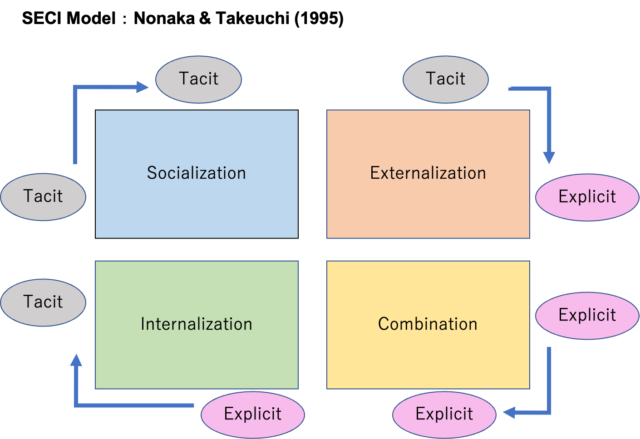
Organizational Knowledge Management by Sharing Tacit Knowledge
Yujiro Yamazaki
- Skills Needed in Labour Market and Issues Related to Skills of Workers
Tacit knowledge refers to knowledge acquired through experience that cannot be explicitly expressed in words. The concept was proposed by the Hungarian philosopher Michael Polanyi, who noted that “we can know more than we can tell.” Tacit knowledge also refers to the cognitive ability to know a person’s face and be able to distinguish it from other faces, but not be able to tell how one does so, and the embodied knowledge acquired through practice, such as how to swim or pedal a bicycle.
Tacit knowledge is often contrasted with explicit knowledge, which is objective, verbal knowledge that can be transferred. Sternberg et al. (1992) point out that not only explicit knowledge that can be taught, but also the formation of tacit knowledge plays an important role in the efficiency of corporate management. Accordingly, how to effectively manage tacit knowledge in a company has been attracting attention. One effective organizational management approach is the SECI model, which is oriented toward the formalization of tacit knowledge. This model is a framework for knowledge management proposed by Nonaka and Takeuchi (1995).

Individuals’ tacit knowledge (tacit knowledge) is transferred by sharing experiences (Socialization), expressing tacit knowledge into words (Externalization), creating systematic explicit knowledge from individual knowledge (Combination) and acquiring tacit knowledge by using systematic explicit knowledge as one’s own know-how (Internalization). Polanyi also explains that when there are two people, one can acquire the knowledge created by the other to some extent, using the term “dwell-in” (Polanyi 1966).
Nonaka and Umemoto (2001) cite several successful examples of the SECI model. One example, Fuji Xerox, worked to implement the SECI model based on the concept of “Design for All.” First, the designers and engineers in each process visited each other’s sites to acquire on-site know-how (Socialization). Then, they input their on-site knowledge, such as their own experience and design know-how, into an online knowledge sharing system (Externalization), identify the best among them, and register and share the formalized design know-how (Combination). Then, this new systematic formal knowledge is acquired again as tacit knowledge (Internalization) by adapting it to the situation in the field. This effort has solved the problem of design changes at the final stage.
The SECI model for sharing tacit knowledge to create formal knowledge and Polanyi’s “dwell-in” model for transferring tacit knowledge point out the importance of sharing a place. It is said that sharing the same place for a long time is a necessary condition for sharing tacit knowledge, and that it is difficult to transfer tacit knowledge among people who are far apart. In the SECI model of sharing tacit knowledge to explicit knowledge and in Polanyi’s “dwell-in” model of tacit knowledge transfer, a shared place is pointed out as an important point. It is said that sharing the same place for a long time is a necessary condition for sharing tacit knowledge, and that it is difficult to transfer tacit knowledge of people who are far apart. However, the current spread of the novel coronavirus has forced us to rethink this aspect. With the spread of the infection, it has become difficult to share a workplace, and remote work has become widely accepted. While technological innovation has made new forms of work possible, the separation of workers from each other has made it difficult to transmit the tacit knowledge that used to be shared. In addition, it is important to note that tacit knowledge of the environment is newly created in the new work style of remote work. Now that over a year has passed since the transformation of work styles, it is necessary not only to be satisfied with the adaptation to digitalization, but also to consider a new approach to knowledge creation in organizations to capture the tacit knowledge that has been transformed along with it.
References
- Nonaka, I. and Takeuchi, H. (1995). The knowledge-creating company. New York, Oxford: Oxford University Press.
- Polanyi, M. (1966) The tacit dimension. London: Routledge & Kegan Paul.
- Sternberg, R. J. & Wagner, R. K. (1992) Tacit knowledge: An unspoken key to managerial success. Creativity and Innovation Management 1 pp. 5-13
- 野中・梅本 (2001) 「知識管理から知識経営へ ーナレッジマネジメントの最新動向-」『人工知能学会誌』 16巻 1号 pp. 4-14.


